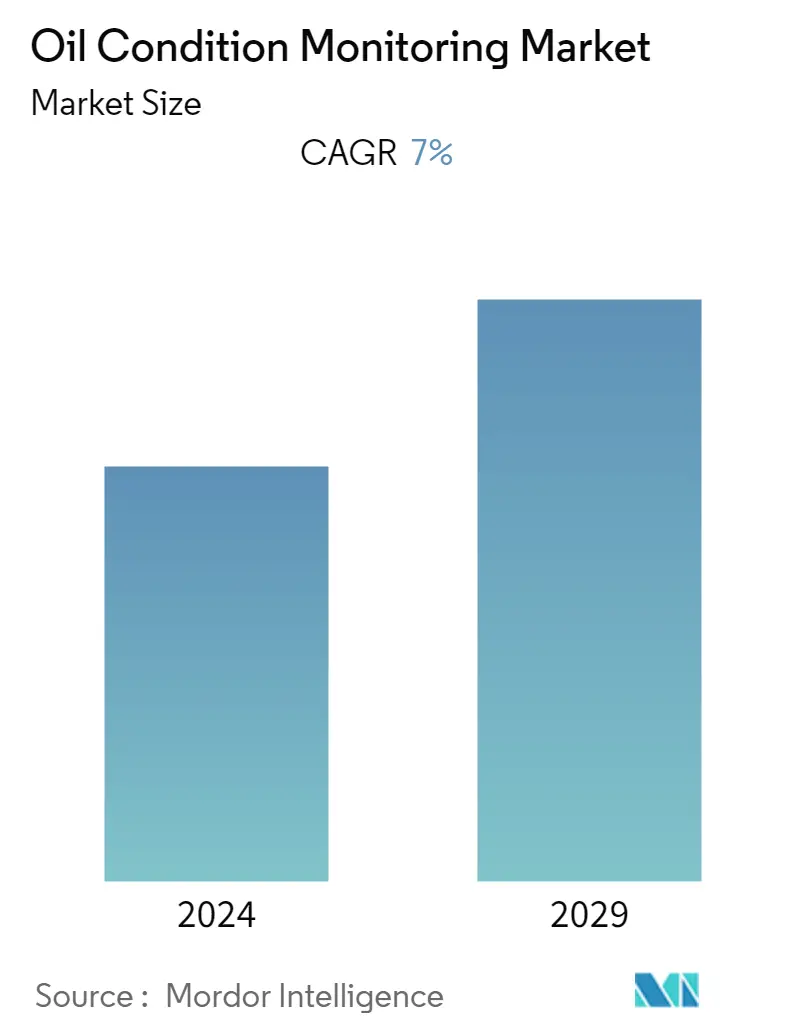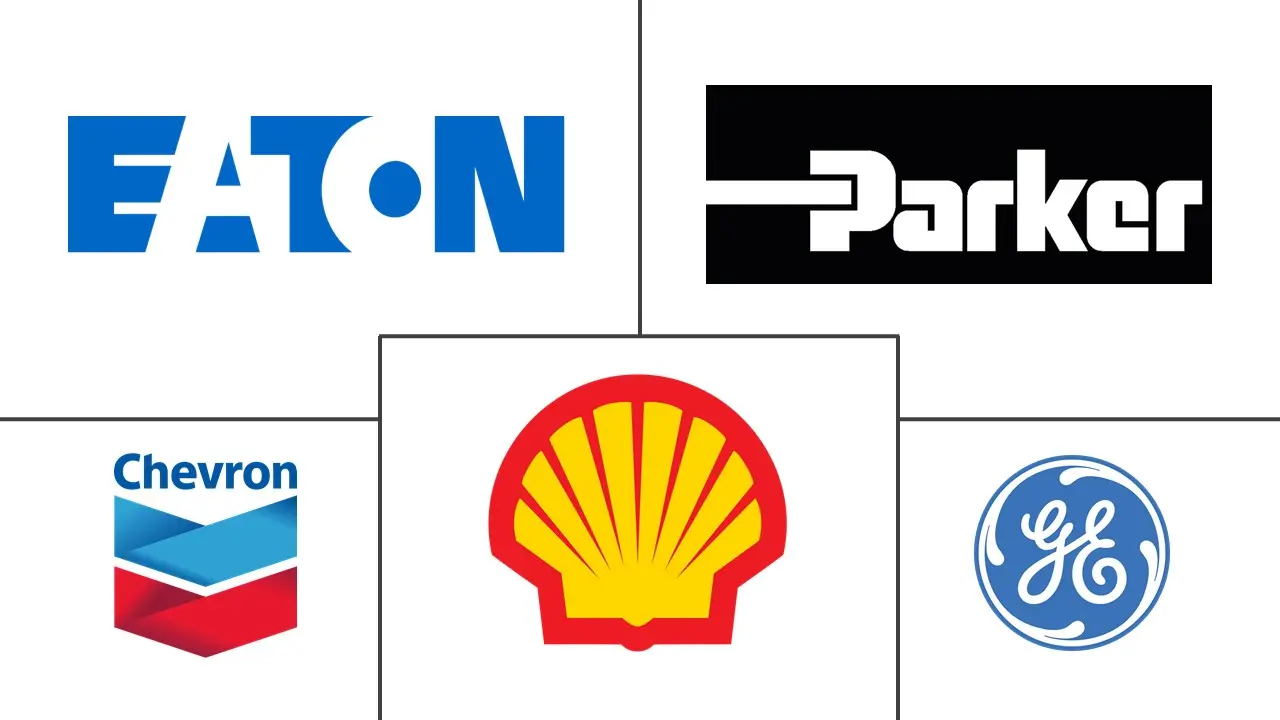Market Size of Oil Condition Monitoring Industry

| Study Period | 2019 - 2029 |
| Base Year For Estimation | 2023 |
| CAGR | 7.00 % |
| Fastest Growing Market | North America |
| Largest Market | North America |
| Market Concentration | Medium |
Major Players
*Disclaimer: Major Players sorted in no particular order |
Oil Condition Monitoring Market Analysis
The market for oil condition monitoring is expected to register a CAGR of 7% over the forecast period (2021 - 2026)
- In the commercial world, businesses constantly look for new ways to support their longevity that also includes the machinery, as operational problems in the machine and other components often are the result of bearing defects, shaft misalignment, couplings, insufficient lubrication, chipped gear teeth among others that can be reflected in the condition of the lubricant oil used owing to this business often rely on lubricant analysis solutions such as oil condition monitoring
- For instance, the business sectors including power, logistics, mining, and manufacturing deploy oil-dependent machines, vehicles that are equipped with gearboxes, engines, hydraulics, and transformers which require regular health and status inspections in order to operate at their maximum efficiency
- Moreover, This instance becomes a critical factor to consider as these sectors operate in extreme and often harsh climatic conditions such as humid mine sites, artic natural gas processing plants among others with oil condition degrading over time and losses its lubrication properties which eventually causes equipment damage
- Although traditional oil analysis techniques such as laboratory testing provide an extensive view of oil condition and machinery health yet it does come with drawbacks such as high upfront cost, time delay, and occasionally malfunctioning, with critical machine potentially cost the organizations thousands of dollars per hour, organization are looking to invest reliable in-line oil analysis solutions such as Oil Condition Monitoring
- Also, with the arrival of real-time measurement sensors for the oil condition monitoring that are inclined towards affordability as compared to the traditional sampling and laboratory technique is driving the growth of the market
- Moreover, The new generation of sensors compliments the flexibility of vibration sensors allowing continuous measurements that can be accessed through the asset management systems dashboard added with the commercial availability of powerful magnets has enhanced the capabilities of ferrous debris sensors, which now allows for the collection of larger failure particles thereby aiding problem diagnosis.
- The oil conduction monitoring is overlooked majorly due to its potentially high-cost implications and practicality however due to limitations associated with scheduled preventive maintenance in terms of effectiveness, organizations tend to foresee the cost of oil condition monitoring sensors to be covered with saving achieved with reduced wastage and extended machine life and energy efficiency which evidently drives the growth of the market
- Furthermore, IIoT-enabled condition monitoring solutions have been advancing rapidly over the years while it is still its infancy phase it aims to digitalize the condition monitoring leveraging technologies such as cloud, big data further drives the growth of market
Oil Condition Monitoring Industry Segmentation
- The Oil Condition Monitoring refers to a predictive maintenance program that measures, monitors, and analyses the changes that occur in lubricant and fuel oils for chemicals and containments. It provides a vital warning regarding the degradation in the quality of oil from new to end-of-life thereby supports the reliability of the machine
- The reports cover the emerging trends in the oil condition monitoring market segmented by sampling type, measurement type, product type, and Industry across different regions studied.
| Sampling Type | |
| On-Site (on-board,fixed continous monitoring) | |
| Off-Site |
| Product Type | |
| Turbine | |
| engines | |
| Gear System | |
| Hydraulic System | |
| Compressors |
| End-user Industry | |
| Transportation | |
| Oil & Gas | |
| Industrial | |
| Mining | |
| Power Generation |
| Geography | ||||||
| ||||||
| ||||||
| ||||||
| ||||||
|
Oil Condition Monitoring Market Size Summary
The oil condition monitoring market is experiencing significant growth, driven by the increasing need for businesses to maintain the longevity and efficiency of machinery used in sectors such as power, logistics, mining, and manufacturing. These industries rely heavily on oil-dependent machines that require regular health inspections to prevent operational issues caused by factors like bearing defects and insufficient lubrication. Traditional oil analysis methods, while comprehensive, often come with high costs and time delays, prompting organizations to invest in more reliable and cost-effective in-line oil analysis solutions. The advent of real-time measurement sensors and IIoT-enabled condition monitoring solutions is further propelling market expansion, offering continuous measurements and digitalization capabilities that enhance machinery health monitoring.
North America holds a significant share of the oil condition monitoring market, supported by established industries like logistics, transportation, and oil & gas, along with the presence of major players such as General Electric and Chevron Corporation. The region's market growth is also bolstered by initiatives aimed at reducing environmental impacts and enhancing aviation safety. Despite the market's moderate fragmentation, key players are leveraging strategic collaborations and technological advancements to expand their product offerings and customer base. However, challenges such as the recent global pandemic have impacted market growth, particularly in sectors like oil & gas and transportation, highlighting the market's sensitivity to economic fluctuations.
Oil Condition Monitoring Market Size - Table of Contents
-
1. MARKET DYNAMICS
-
1.1 Market Overview
-
1.2 Market Drivers
-
1.3 Market Restraints
-
1.4 Value Chain Analysis
-
1.5 Porters Five Force Analysis
-
1.5.1 Threat of New Entrants
-
1.5.2 Bargaining Power of Buyers/Consumers
-
1.5.3 Bargaining Power of Suppliers
-
1.5.4 Threat of Substitute Products
-
1.5.5 Intensity of Competitive Rivalry
-
-
1.6 Assesment of COVID-19 Impact on the Industry
-
1.7 Technology Snapshot - Oil Condition Monitoring Market by Measurement Type (Viscosity, Temperature, Pressure, Density, Tan & TBN, Soot, Ferrous Wear, Water Dilutions, Fuel Dilution, Dielectric)
-
-
2. MARKET SEGMENTATION
-
2.1 Sampling Type
-
2.1.1 On-Site (on-board,fixed continous monitoring)
-
2.1.2 Off-Site
-
-
2.2 Product Type
-
2.2.1 Turbine
-
2.2.2 engines
-
2.2.3 Gear System
-
2.2.4 Hydraulic System
-
2.2.5 Compressors
-
-
2.3 End-user Industry
-
2.3.1 Transportation
-
2.3.2 Oil & Gas
-
2.3.3 Industrial
-
2.3.4 Mining
-
2.3.5 Power Generation
-
-
2.4 Geography
-
2.4.1 North America
-
2.4.1.1 United States
-
2.4.1.2 Canada
-
-
2.4.2 Europe
-
2.4.2.1 Germany
-
2.4.2.2 United Kingdom
-
2.4.2.3 France
-
2.4.2.4 Rest of Europe
-
-
2.4.3 Asia-Pacific
-
2.4.3.1 India
-
2.4.3.2 China
-
2.4.3.3 Japan
-
2.4.3.4 Rest of Asia-Pacific
-
-
2.4.4 Latin America
-
2.4.4.1 Brazil
-
2.4.4.2 Argentina
-
2.4.4.3 Rest of Latin America
-
-
2.4.5 Middle East and Africa
-
2.4.5.1 United Arab Emirates
-
2.4.5.2 Saudi Arabia
-
2.4.5.3 Rest of Middle East and Africa
-
-
-
Oil Condition Monitoring Market Size FAQs
What is the current Oil Condition Monitoring Market size?
The Oil Condition Monitoring Market is projected to register a CAGR of 7% during the forecast period (2024-2029)
Who are the key players in Oil Condition Monitoring Market?
General Electric, Royal Dutch Shell PLC, Eaton Corporation Inc, Parker-Hannifin Corporation and Chevron Corporation are the major companies operating in the Oil Condition Monitoring Market.

